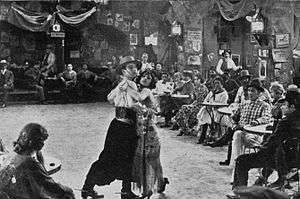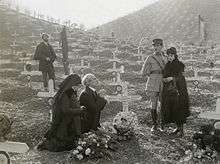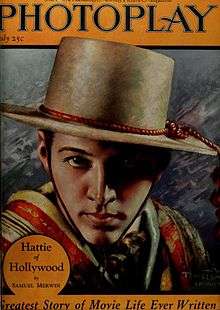The Four Horsemen of the Apocalypse (film)
| The Four Horsemen of the Apocalypse | |
|---|---|
|
Metro Pictures poster for the film (1921) | |
| Directed by | Rex Ingram |
| Produced by | Rex Ingram |
| Screenplay by | June Mathis |
| Based on |
The Four Horsemen of the Apocalypse by Vicente Blasco Ibáñez |
| Starring |
Pomeroy Cannon Josef Swickard Bridgetta Clark Rudolph Valentino Wallace Beery Alice Terry |
| Music by | Louis F. Gottschalk |
Production company |
Rex Ingram Productions |
| Distributed by | Metro Pictures |
Release dates |
|
Running time |
134 minutes (edited version) 156 minutes (complete version) |
| Country | United States |
| Language |
Silent English intertitles |
| Box office | $4.5 million[1][2] |
The Four Horsemen of the Apocalypse is a 1921 American silent epic war film produced by Metro Pictures Corporation and directed by Rex Ingram. Based on the Spanish novel The Four Horsemen of the Apocalypse by Vicente Blasco Ibáñez, it was adapted for the screen by June Mathis. The film stars Pomeroy Cannon, Josef Swickard, Bridgetta Clark, Rudolph Valentino, Wallace Beery, and Alice Terry.[3]
Often regarded as one of the first true anti-war films, it had a huge cultural impact and became the top-grossing film of 1921, beating out Charlie Chaplin's The Kid. The film turned then-little-known actor Rudolph Valentino into a superstar and associated him with the image of the Latin Lover. The film also inspired a tango craze and such fashion fads as gaucho pants.[4] The film was masterminded by June Mathis, who, with its success, became one of the most powerful women in Hollywood at the time.[5][6]
In 1995, The Four Horsemen of the Apocalypse was selected for preservation in the United States National Film Registry by the Library of Congress as being "culturally, historically, or aesthetically significant". The film is now in the public domain, having been made before 1923. A DVD version was released in 2000 but is now out of print. The film is now available for free download on the Internet Archive.[7]
Plot
.webm.jpg)
Madariaga "The Centaur" (Pomeroy Cannon), a harsh but popular Argentine landowner, has a German son-in-law whom he dislikes and a French one whose family he openly favors. He is particularly fond of his grandson Julio (Rudolph Valentino), with whom he often carouses at seedy dives in the Boca district of Buenos Aires. In one of these bars, the movie's famous tango sequence occurs. A man and a woman (Beatrice Dominguez) are dancing the tango. Julio strides up and asks to cut in. The woman stares at Julio alluringly. The man brushes him off, and they resume dancing. Julio then challenges the man and strikes him, knocking him into some tables and out of the scene. Julio and the woman then dance a dramatic version of the tango that brings cheers from the people in the establishment. Following the dance, the woman sits on Julio's lap. Madariaga then slides to the floor, drunk. The woman laughs at Madariaga. Julio casts her aside in scorn and helps his grandfather home.
Sometime later, Madariaga dies. The extended family breaks up, one half returning to Germany and the other to France.
In Paris, Julio enjoys a somewhat shiftless life as a would-be artist and sensation at the local tea dances. He falls in love with Marguerite Laurier (Alice Terry), the unhappy and much younger wife (by an arranged marriage) of Etienne Laurier, a friend of Julio's father. The affair is discovered, and Marguerite's husband agrees to give her a divorce to avoid a scandal. It seems as though Julio and Marguerite will be able to marry, but both end up getting caught up in the start of the Great War.
_-_1.jpg)
Marguerite becomes a nurse in Lourdes. The bravery of Etienne is reported, and he is blinded in battle. Etienne happens to end up at the hospital where she is working, and Marguerite attends to him there. Julio travels to Lourdes to see Marguerite and instead sees her taking care of Etienne. Julio, ashamed of his wastrel life, enlists in the French Army.
In the meantime, the German Army overruns Julio's father Marcelo's Marne Valley castle in the First Battle of the Marne. Marcelo is forced to host a German general and staff in the castle. One of Marcelo's three German nephews is amongst the staff and tries to protect him, but Marcelo is arrested after a melee involving an officer's assault of a woman. Marcello is to be executed in the morning, but his life is spared when the French Army counterattacks in the "Miracle of the Marne". The castle is destroyed by the French counterattack.
Four years later Julio has survived and become renowned for his bravery in the trenches at the front. During a mission in no man's land, he encounters his last surviving German cousin. Moments later, they are both killed by a shell. Back in Paris, Marguerite considers abandoning the blinded Etienne, but Julio's ghost guides her to continue her care for him.
The ending scene shows Marcelo Desnoyers mourning over his son's grave. The man who lived upstairs from Julio watches over him. Marcelo asks him, "did you know my son?" The man, with a remorseful expression, lifts his arms, forming the shape of a cross with his body, and says "I knew them all!" He then points to the sky and shows Marcelo the Four Horsemen of the Apocalypse riding away into the clouds. With this, the man assures him that "Peace has come—but the Four Horsemen will still ravage humanity—stirring unrest in the world—until all hatred is dead and only love reigns in the heart of mankind."
Cast

|
|
Production
_-_St_Polis_Terry_%26_Valentino.jpg)
In 1919, screenwriter June Mathis became head of the scenario department for Metro Pictures.[8] With this position, she became one of the first female executives in film history.[8] Holding a major belief in Spiritualism and the Book of Revelation, Mathis was determined to turn Vicente Blasco Ibáñez's novel The Four Horseman of the Apocalypse into a film. The book had been a best seller, but most studios found it impossible to adapt to film.[8]
Mathis's adaptation so impressed the studio, they asked for her input in director and star. For director, she chose Rex Ingram, who would clash with both her and Valentino.[8][9] Mathis had seen a young actor named Rudolph Valentino in a bit part of a Clara Kimball Young film, Eyes of Youth, in 1919.[10][11] Valentino had arrived in Hollywood in 1918, where he had worked in many B movies, including All Night with Carmel Myers and The Delicious Little Devil with Mae Murray.[12] He also worked on a picture with Julian Eltinge and Virginia Rappe that would eventually become The Isle of Love. It has been suggested Mathis might have first seen him in that film, as she was a close friend of Eltinge.[11]
Mathis insisted Valentino would play Julio; however, studio executives were nervous with the young actor. Valentino, whose parents were French and Italian, had a distinctly Latin look that had not been used much in pictures at that time.[13] However, Mathis got her way, and after seeing the rushes, she and Ingram decided to expand the role of Julio to showcase the talents of Valentino. Valentino had worked as a taxi dancer during his time in New York. To show off his dancing skills, the tango scene was included, though it was not part of the original story.

Alice Terry, a former Follies Girl, was cast as Julio's lover, Marguerite. She would marry Ingram that same year.
Metro paid Ibanez $20,000 and 10% of the gross earnings for the rights to adapt his novel.[14] The film took six months to shoot, cost $80,000, and had a cast of 72 "principal players". Valentino was only paid $350 a week, which was much less than other players. To add to his troubles, he also had to provide his own costumes, which he spent thousands on. The French Marne village was constructed at Griffith Park in Los Angeles, California. In the scenes between Julio and Marguerite, Valentino and Terry spoke French to impress lip readers. Valentino was fluent in French, as his mother was French.[15]
Mathis also injected some early depictions of alternative lifestyles; it featured a scene with German officers coming down the stairs in drag. Of the scene, Mathis would later tell the Los Angeles Times, "I had the German officers coming down the stairs with women's clothing on. To hundreds of people that meant no more than a masquerade party. To those who have lived and read, and who understand life, that scene stood out as one of the most terrific things in the picture."[6]
Reception

The film premiered in New York to great critical acclaim. Many critics hailed it as a new Birth of a Nation. However, the German press was less enthused with the portrayal of Germans in the film.
The film became a commercial success as well, and was one of the first films to make $1,000,000 at the box office. The film is considered to be the sixth-best-selling silent film of all time.[10][16] During its initial run, it grossed $4,500,000 domestically.
With its extended scenes of the devastated French countryside and personalized story of loss, The Four Horsemen of the Apocalypse is often considered to be one of the first anti-war films made.
Some aspects of the film were controversial with American film censorship boards. For example, the Pennsylvania board, upon reviewing the affair between Julio and Marguerite, required that Marguerite be described in intertitles as being the fiancée of Etienne Laurier rather than his wife.[17]
Picture-Play Magazine reviewed The Four Horsemen of the Apocalypse in their April 1921 issue, saying "The Four Horsemen may have been a spectacular and million-dollar flivver. As it is, it is an artistic triumph." They also praised the cast. "Rudolph Valentino plays the rôle of Julio Desnoyers. He is such a fine actor that you forget how handsome he is and how well he dances. Alice Terry as Marguerite looks and acts like another Blanche Sweet. In plain and simple words, the cast is a wonder."[18]
The film made Mathis one of the most powerful and respected women in Hollywood, said to be only second to Mary Pickford.[6] She was one of the highest-paid executives of her time and went on to work with Famous Players-Lasky and Goldwyn Pictures.[19] She became known for association with Valentino, who became a close friend. She wrote many more films for him, helping to shape his image.[20]
Julio proved to be a breakthrough role for Valentino, who became a superstar overnight. He became heavily associated with the image of a "Latin lover", though eventually his image as "The Sheik" may have overshadowed this. Metro refused to acknowledge that they had made a star and immediately put him into a B-picture titled Uncharted Seas.[9][20] Valentino soon left them for Famous Players-Lasky.[20]
The film also helped launch the name of Ingram. Ingram came to resent the break-out success of Valentino, as he felt it was his own work that made Four Horsemen a success. He went on to make films with Terry and eventually discovered Ramon Novarro, whom he promoted as the new Valentino[21] and who appeared as an extra in this film.[22]
Adaptations and remakes
_Lobby_Card_4.jpg)
- The film was remade as 4 Horsemen of the Apocalypse (1962), with the setting changed to World War II. Vincente Minnelli was the director.
In popular culture
- The tango sequence was parodied by Gene Wilder during the opening credits of The World's Greatest Lover (1977).
See also
References
Notes
- ↑ "Which Cinema Films Have Earned the Most Money Since 1914?". The Argus (Melbourne, Vic. : 1848 - 1956). Melbourne, Vic.: National Library of Australia. 4 March 1944. p. 3 Supplement: The Argus Weekend magazine. Retrieved 6 August 2012.
- ↑ "All-Time Top Grossers", Variety, 8 January 1964 p 69
- ↑ The Four Horsemen of the Apocalypse at silentera.com
- ↑ Leider, Emily W., Dark Lover: The Life and Death of Rudolph Valentino, p. 219
- ↑ Alt Film Guide.
- 1 2 3 Journal of Humanities. 2007.
- ↑ 3 The Four Horsemen on the Apocalypse on the Internet Archive.
- 1 2 3 4 Maher. 2006. p.200
- 1 2 Leider, Emily W., Dark Lover. pp. 111-130.
- 1 2 Botham, Noel (2002). Valentino: The First Superstar. Metro Publishing Ltd. ISBN 1-84358-013-6.
- 1 2 Rambova, Natacha (2009) [1921]. Rudolph Valentino: A Wife's Memories of an Icon. Hollywood, California: PVG Publishing. pp. 243–44. ISBN 978-0-9816440-4-2.
- ↑ Leider, Emily W., Dark Lover: The Life and Death of Rudolph Valentino, pp. 81-83.
- ↑ Leider, Emily W., Dark Lover. pp. 61-85.
- ↑ Schulman. 1967.
- ↑ Leider, 2004.
- ↑ Biggest Money Pictures. CinemaWeb.com.
- ↑ Smith, Frederick James (Oct 1922). "Foolish Censors". Photoplay. New York. 22 (5): 39–40. Retrieved Dec 3, 2013.
- ↑ Smith, Agnes (April 1921). "The Screen in Review". Picture-Play Magazine. 14: 56. Retrieved August 18, 2015.
- ↑ LA Times, 1923.
- 1 2 3 Leider, Emily W., Dark Lover. pp. 131-150.
- ↑ Soares, André. Beyond Paradise: The Life of Ramon Novarro. New York: Macmillan, 2002, p. 27. ISBN 0-312-28231-1
- ↑ (1924). "The Man from the Mob" Photoplay
Bibliography
- Acker, Ally; Wanamaker, Marc (1991). Reel Women: Pioneers of the Cinema 1896 to the Present. London: Batsford. ISBN 0-7134-6960-9.
- Ellenberger, Allan R. (2007-04-01). "June Mathis: Author Allan Ellenberger Discusses One of the Most Powerful Women in Hollywood History". ALT Film Guide.
- Ellenberger, Allan R. (2005). The Valentino Mystique: The Death and Afterlife of the Silent Film Idol. Jefferson, N.C.: McFarland & Co. ISBN 0-7864-1950-4.
- Koszarski, Richard (1983). The Man You Loved to Hate: Erich von Stroheim and Hollywood. Oxford [Oxfordshire]: Oxford University Press. ISBN 0-19-503379-5.
- Leider, Emily Wortis (2004). Dark Lover: The Life and Death of Rudolph Valentino. New York: Faber and Faber Inc. ISBN 0-571-21114-3.
- Lipke, Kathleen (June 3, 1923). "the Most Responsible Job Ever Held by a Woman". Los Angeles Times: 13.
- Mahar, Karen Ward (2006). Women Filmmakers in Early Hollywood (Studies in Industry and Society). Baltimore: The Johns Hopkins University Press. ISBN 0-8018-8436-5.
- Slater, Thomas (2007-11-03). "June Mathis: Moving the Margins of Mainstream". Journal of Humanities.
- Slater, Thomas (1984). 'June Mathis': Dictionary of Literary Biography. 44, American screenwriters: second series. Detroit, Mich: Gale Research Co. p. 246. ISBN 0-8103-1722-2.
- Shulman, Irving (1967). Valentino. New York: Simon & Schuster.
- Unterburger, Amy L. (1999). The St. James Women Filmmakers Encyclopedia: Women on the Other Side of the Camera. Detroit, MI: Visible Ink Press. ISBN 1-57859-092-2.
External links
| Wikiquote has quotations related to: The Four Horsemen of the Apocalypse (film) |
| Wikimedia Commons has media related to The Four Horsemen of the Apocalypse (film). |
- The Four Horsemen of the Apocalypse on YouTube
- The Four Horsemen of the Apocalypse at the Internet Movie Database
- The Four Horsemen of the Apocalypse is available for free download at the Internet Archive
- The Four Horsemen of the Apocalypse at AllMovie
